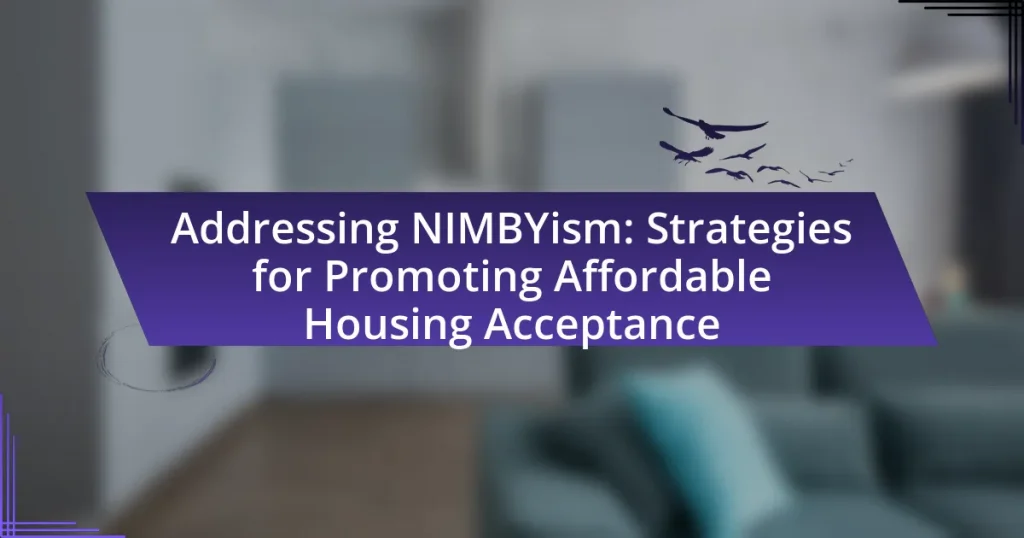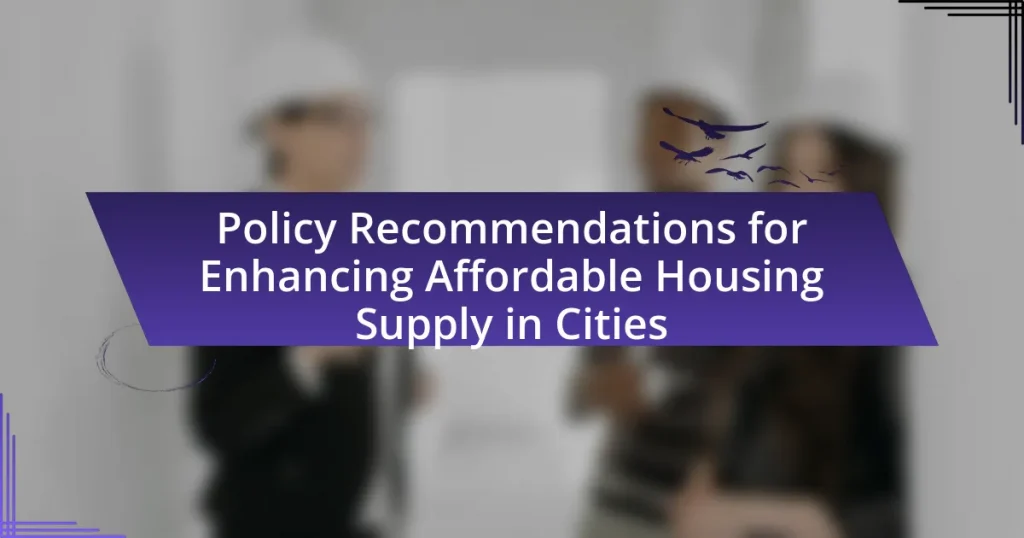Public-Private Partnerships (PPPs) in affordable housing are collaborative agreements between government entities and private sector companies designed to develop, finance, and manage affordable housing projects. This article explores how PPPs function, highlighting their key components such as shared risk, collaboration, and resource allocation, which facilitate the creation of affordable housing solutions. It also addresses the importance of these partnerships in overcoming challenges in housing markets, enhancing housing quality, and stimulating local economies. Furthermore, the article discusses the benefits and challenges of PPPs, future trends, and practical strategies for improving their effectiveness in addressing the growing demand for affordable housing.

What are Public-Private Partnerships in Affordable Housing?
Public-Private Partnerships (PPPs) in affordable housing are collaborative agreements between government entities and private sector companies aimed at developing, financing, and managing affordable housing projects. These partnerships leverage the strengths of both sectors; the public sector provides regulatory support and funding, while the private sector contributes expertise, efficiency, and capital investment. For instance, a study by the Urban Institute highlights that PPPs can reduce costs and expedite the construction of affordable housing units, addressing housing shortages effectively.
How do Public-Private Partnerships function in the context of affordable housing?
Public-Private Partnerships (PPPs) function in the context of affordable housing by combining resources and expertise from both the public sector and private developers to create housing solutions that are financially viable and accessible. In these partnerships, the government typically provides land, regulatory support, or funding, while private entities contribute construction expertise, financing, and management capabilities. For example, in the United States, the Low-Income Housing Tax Credit program incentivizes private investment in affordable housing projects, demonstrating how PPPs can effectively mobilize private capital to meet public housing needs. This collaborative approach not only enhances the efficiency of housing development but also addresses the critical shortage of affordable housing in many urban areas.
What are the key components of Public-Private Partnerships?
The key components of Public-Private Partnerships (PPPs) include shared risk, collaboration, and resource allocation. Shared risk involves both public and private entities taking on specific risks associated with a project, which encourages joint investment and commitment. Collaboration refers to the partnership’s cooperative efforts in planning, financing, and executing projects, ensuring that both parties contribute their expertise and resources effectively. Resource allocation pertains to the distribution of financial, human, and technological resources between the public and private sectors, optimizing efficiency and project outcomes. These components are essential for the successful implementation of PPPs, particularly in sectors like affordable housing, where leveraging both public and private strengths can lead to innovative solutions and improved service delivery.
How do these components interact to facilitate affordable housing?
Public-private partnerships (PPPs) facilitate affordable housing by combining resources, expertise, and risk-sharing between government entities and private developers. These collaborations enable the efficient allocation of funding, with public entities often providing subsidies or incentives that lower development costs, while private developers contribute innovation and efficiency in construction and management. For instance, a study by the Urban Institute found that PPPs can reduce the time and cost of housing projects by up to 30%, making it feasible to deliver more affordable units. Additionally, these partnerships often leverage land use policies and zoning regulations to streamline approvals, further enhancing the speed and affordability of housing development.
Why are Public-Private Partnerships important for affordable housing?
Public-Private Partnerships (PPPs) are important for affordable housing because they leverage resources, expertise, and risk-sharing between the public and private sectors to create sustainable housing solutions. By combining public funding and regulatory support with private investment and innovation, PPPs can accelerate the development of affordable housing projects. For instance, a study by the Urban Institute found that PPPs can reduce costs and increase the speed of housing development, making it possible to deliver more units to meet growing demand. This collaborative approach not only enhances the efficiency of housing projects but also ensures that they are designed to meet community needs effectively.
What challenges do Public-Private Partnerships address in housing markets?
Public-Private Partnerships (PPPs) address several challenges in housing markets, primarily the lack of affordable housing, insufficient funding, and inefficiencies in project delivery. These partnerships leverage the strengths of both sectors; public entities provide regulatory support and land access, while private entities contribute capital, expertise, and innovation. For instance, in the United States, PPPs have been instrumental in developing affordable housing projects, with the National Housing Conference reporting that such collaborations can reduce costs by up to 20% compared to traditional methods. Additionally, PPPs help streamline processes, enabling faster project completion and better alignment with community needs, thus effectively tackling the housing crisis.
How do these partnerships enhance housing affordability?
Public-private partnerships enhance housing affordability by leveraging resources and expertise from both sectors to reduce costs and increase the supply of affordable housing units. These collaborations often result in innovative financing solutions, such as tax credits and grants, which lower the financial burden on developers and ultimately lead to lower rents for tenants. For instance, a study by the Urban Institute found that projects utilizing public-private partnerships can reduce construction costs by up to 20%, making housing more accessible to low-income families.

What are the benefits of Public-Private Partnerships in Affordable Housing?
Public-Private Partnerships (PPPs) in affordable housing provide several key benefits, including increased funding, risk-sharing, and enhanced efficiency in project delivery. These partnerships leverage the strengths of both sectors; public entities contribute regulatory support and land, while private developers bring capital and expertise. For instance, a study by the Urban Institute found that PPPs can reduce project costs by up to 20% through streamlined processes and innovative financing solutions. Additionally, PPPs often lead to faster construction timelines, enabling quicker access to affordable housing for communities in need.
How do Public-Private Partnerships improve housing quality?
Public-Private Partnerships (PPPs) improve housing quality by leveraging the strengths of both sectors to deliver better construction standards and maintenance practices. These collaborations often result in increased investment in housing projects, which can lead to the use of higher-quality materials and innovative building techniques. For instance, a study by the Urban Institute found that PPPs can enhance project efficiency and reduce costs, allowing for more resources to be allocated towards quality improvements. Additionally, PPPs often include performance-based contracts that incentivize private developers to maintain high standards throughout the lifecycle of the housing project, ensuring ongoing quality for residents.
What role does innovation play in enhancing housing quality?
Innovation plays a crucial role in enhancing housing quality by introducing advanced materials, construction techniques, and smart technologies that improve durability, efficiency, and livability. For instance, the use of prefabricated construction methods can significantly reduce building time and costs while maintaining high standards of quality. Additionally, innovations such as energy-efficient systems and sustainable materials contribute to lower utility costs and a reduced environmental footprint, which are essential for affordable housing initiatives. Research by the McKinsey Global Institute indicates that adopting innovative construction practices can lead to a 20-30% reduction in costs and time, thereby making housing more accessible and of higher quality.
How do these partnerships ensure sustainable development?
Public-private partnerships (PPPs) ensure sustainable development by leveraging resources, expertise, and innovation from both sectors to create affordable housing solutions. These collaborations enable efficient allocation of financial resources, reducing the burden on public budgets while enhancing project viability through private sector investment. For instance, a study by the World Bank highlights that PPPs can lead to a 20-30% reduction in project costs and time, facilitating quicker delivery of housing projects. Additionally, PPPs often incorporate sustainable practices, such as energy-efficient building designs and environmentally friendly materials, which contribute to long-term ecological sustainability. This dual focus on cost-effectiveness and sustainability makes PPPs a crucial mechanism for achieving sustainable development in the housing sector.
What economic impacts do Public-Private Partnerships have on communities?
Public-Private Partnerships (PPPs) significantly enhance economic development in communities by leveraging private investment to fund public projects. These partnerships often lead to improved infrastructure, such as roads and public transportation, which can stimulate local economies by increasing accessibility and attracting businesses. For instance, a study by the World Bank found that PPPs in infrastructure can lead to a 30% increase in project efficiency and a reduction in public sector costs by up to 20%. Additionally, PPPs can create jobs during both the construction and operational phases, contributing to lower unemployment rates and higher local income levels.
How do these partnerships stimulate local economies?
Public-private partnerships (PPPs) stimulate local economies by leveraging resources and expertise from both sectors to create affordable housing projects. These collaborations lead to job creation, as construction and ongoing maintenance require a workforce, thereby reducing unemployment rates in the community. Additionally, affordable housing increases the local tax base, as new developments generate property taxes that can be reinvested into community services. For instance, a study by the Urban Institute found that every $1 million invested in affordable housing can create approximately 17 jobs, demonstrating the direct economic impact of such partnerships. Furthermore, by providing stable housing, these initiatives enhance residents’ economic stability, leading to increased consumer spending in local businesses.
What are the long-term financial benefits for stakeholders?
Long-term financial benefits for stakeholders in public-private partnerships (PPPs) in affordable housing include increased property values, stable rental income, and reduced financial risk. Stakeholders, such as investors and local governments, benefit from enhanced property values due to improved housing quality and community development, which can lead to a 10-20% increase in property values over time, as evidenced by studies on urban revitalization. Additionally, stakeholders enjoy stable rental income from affordable housing projects, which typically have lower vacancy rates compared to market-rate housing, providing consistent cash flow. Furthermore, PPPs distribute financial risk between public and private entities, minimizing the burden on any single stakeholder and promoting sustainable investment in affordable housing initiatives.

What are the challenges faced by Public-Private Partnerships in Affordable Housing?
Public-Private Partnerships (PPPs) in affordable housing face several significant challenges, including funding constraints, regulatory hurdles, and alignment of interests between public and private entities. Funding constraints often arise from limited public resources and the need for private investors to achieve adequate returns, which can hinder project feasibility. Regulatory hurdles include complex zoning laws and lengthy approval processes that can delay project timelines and increase costs. Additionally, misalignment of interests can occur when public entities prioritize social outcomes while private partners focus on profitability, leading to conflicts that can jeopardize project success. These challenges are documented in various studies, such as the “Public-Private Partnerships in Housing: A Review of the Evidence” by the Urban Institute, which highlights the importance of addressing these issues to enhance the effectiveness of PPPs in delivering affordable housing solutions.
What common obstacles do these partnerships encounter?
Public-private partnerships in affordable housing commonly encounter obstacles such as misaligned goals, funding challenges, and regulatory hurdles. Misaligned goals can lead to conflicts between public entities seeking social outcomes and private partners focused on profit, which can hinder project progress. Funding challenges arise from the difficulty in securing adequate financial resources, often due to budget constraints or differing investment priorities between public and private sectors. Regulatory hurdles include complex zoning laws and compliance requirements that can delay project timelines and increase costs, making it difficult for partnerships to achieve their objectives efficiently.
How can regulatory issues hinder Public-Private Partnerships?
Regulatory issues can significantly hinder Public-Private Partnerships (PPPs) by creating barriers to project implementation and increasing compliance costs. For instance, complex regulatory frameworks can lead to delays in project approvals, discouraging private sector investment. According to a report by the World Bank, regulatory uncertainty is a major factor that can reduce the willingness of private entities to engage in PPPs, as it complicates risk assessment and financial planning. Furthermore, stringent regulations may impose additional operational constraints, limiting the flexibility needed for effective collaboration between public and private sectors.
What financial risks are associated with these partnerships?
Financial risks associated with public-private partnerships in affordable housing include funding shortfalls, cost overruns, and revenue fluctuations. Funding shortfalls can occur if projected financing does not materialize, impacting project viability. Cost overruns may arise from unforeseen expenses during construction or operation, leading to budgetary constraints. Revenue fluctuations can result from changes in market demand or occupancy rates, affecting the financial sustainability of the partnership. According to a study by the Urban Institute, 30% of public-private partnerships in housing projects experience significant financial challenges, highlighting the importance of thorough risk assessment and management strategies.
How can challenges be mitigated in Public-Private Partnerships?
Challenges in Public-Private Partnerships (PPPs) can be mitigated through effective communication, clear contractual agreements, and stakeholder engagement. Effective communication ensures that all parties understand their roles and responsibilities, reducing misunderstandings that can lead to conflicts. Clear contractual agreements outline expectations, performance metrics, and risk-sharing mechanisms, which help in managing uncertainties. Stakeholder engagement fosters collaboration and trust, allowing for the identification and resolution of potential issues early in the process. Research indicates that successful PPPs in affordable housing projects often incorporate these strategies, leading to improved project outcomes and sustainability.
What best practices can enhance the effectiveness of these partnerships?
Establishing clear communication channels enhances the effectiveness of public-private partnerships in affordable housing. Effective communication ensures that all stakeholders, including government entities, private developers, and community organizations, are aligned on goals, expectations, and progress. Research indicates that projects with regular updates and open dialogue experience fewer misunderstandings and delays, leading to more successful outcomes. For instance, the National Council for Public-Private Partnerships highlights that transparency in decision-making processes fosters trust and collaboration, which are critical for the sustainability of such partnerships.
How can stakeholder engagement improve outcomes?
Stakeholder engagement can improve outcomes by fostering collaboration and ensuring that diverse perspectives are considered in decision-making processes. When stakeholders, including community members, government entities, and private sector partners, actively participate, they contribute valuable insights that lead to more effective and sustainable solutions. Research indicates that projects with strong stakeholder involvement are 30% more likely to meet their objectives, as they align better with community needs and expectations. This alignment enhances trust and support, ultimately resulting in higher satisfaction and better long-term success of initiatives, particularly in the context of affordable housing.
What are the future trends for Public-Private Partnerships in Affordable Housing?
Future trends for Public-Private Partnerships (PPPs) in affordable housing include increased collaboration between government entities and private developers, focusing on innovative financing models and sustainable building practices. As urbanization continues to rise, PPPs are expected to leverage technology for efficient project management and data-driven decision-making, enhancing transparency and accountability. Additionally, there is a growing emphasis on mixed-income developments that integrate affordable housing within broader community frameworks, promoting social equity. According to a report by the Urban Institute, these trends are driven by the need for scalable solutions to housing shortages and the recognition of the private sector’s role in addressing public needs.
How is technology shaping the future of these partnerships?
Technology is shaping the future of public-private partnerships in affordable housing by enhancing collaboration, improving efficiency, and enabling data-driven decision-making. Digital platforms facilitate real-time communication between stakeholders, allowing for streamlined project management and resource allocation. For instance, the use of Building Information Modeling (BIM) allows for better visualization and planning of housing projects, reducing costs and time overruns. Additionally, data analytics tools enable partners to assess community needs and housing market trends more accurately, leading to more effective strategies for addressing affordability. These technological advancements are supported by studies indicating that projects utilizing such tools can achieve up to 30% cost savings and 20% faster completion times, demonstrating their significant impact on the effectiveness of partnerships in the affordable housing sector.
What role will policy changes play in the evolution of Public-Private Partnerships?
Policy changes will significantly influence the evolution of Public-Private Partnerships (PPPs) by shaping regulatory frameworks, funding mechanisms, and operational guidelines. These changes can enhance collaboration between public entities and private investors, leading to more innovative and efficient solutions in affordable housing. For instance, the introduction of tax incentives or streamlined approval processes can attract private investment, as evidenced by the success of the Low-Income Housing Tax Credit program in the United States, which has facilitated the development of over 3 million affordable housing units since its inception. Thus, effective policy changes are crucial for optimizing the potential of PPPs in addressing housing shortages.
What practical strategies can enhance the success of Public-Private Partnerships in Affordable Housing?
Practical strategies that can enhance the success of Public-Private Partnerships (PPPs) in affordable housing include establishing clear objectives, fostering strong communication, and ensuring equitable risk-sharing. Clear objectives align the interests of both public and private entities, facilitating a shared vision for project outcomes. Strong communication channels promote transparency and collaboration, which are essential for addressing challenges and adapting to changing circumstances. Equitable risk-sharing ensures that both parties are invested in the project’s success, reducing the likelihood of conflicts and fostering a cooperative environment. Evidence from successful PPP projects, such as the Housing Partnership Network’s initiatives, demonstrates that these strategies lead to improved project delivery and community impact.



